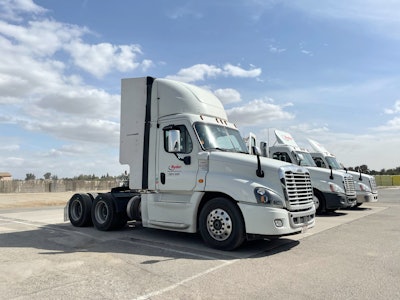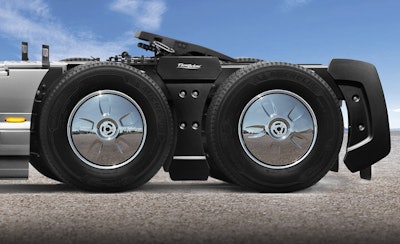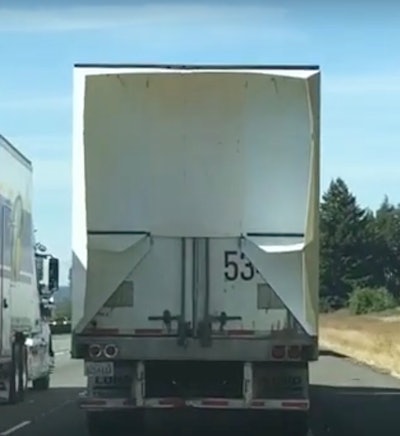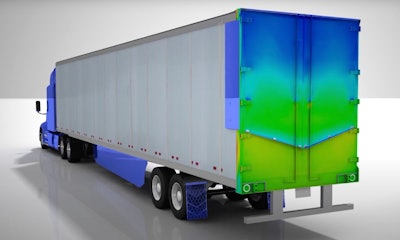Rising fuel prices, an embattled economy and growing pressure to cut carbon has buoyed interest in trucking aerodynamics despite some trepidation that remains over driver-deployed boat tails.
While frequently delivering impressive fuel gains exceeding 5%, manually deployed boat tails mounted on rear trailer doors can be crushed at loading docks if drivers neglect to close them – even when drivers remembered to open them in the first place – and struck in busy lots by other trucks.
California-based TruckLabs passed over boat tails and instead focused on decreasing the air gap between truck and trailer with its back-of-cab mounted TruckWings. Drag reduction results in an advertised fuel savings of 4% to 6% at highway speeds.
 Though TruckLabs advertises a 3 to 6% fuel savings with TruckWings, it’s the C02 reduction that takes center stage on their website’s homepage. “For certain customers it’s even more important than the fuel savings, and that’s with diesel at five bucks a gallon. I don’t think I’ve ever seen an industry change so fast,” TruckLabs founder and CEO Daniel Burrows said of fleets growing interest in meeting ESG goals by way of cutting carbon.TruckLabs
Though TruckLabs advertises a 3 to 6% fuel savings with TruckWings, it’s the C02 reduction that takes center stage on their website’s homepage. “For certain customers it’s even more important than the fuel savings, and that’s with diesel at five bucks a gallon. I don’t think I’ve ever seen an industry change so fast,” TruckLabs founder and CEO Daniel Burrows said of fleets growing interest in meeting ESG goals by way of cutting carbon.TruckLabs
[Related: No magic bullet for trailer aerodynamics]
In addition to being able to track live fuel reduction metrics, TruckWings also allows for live carbon tracking at a time when major investment groups and government agencies alike are more closely monitoring company progress around ESG goals.
“It’s now probably our number one selling point,” TruckLabs founder and CEO Daniel Burrows said. “Plus, diesel prices have been going really high. But several of our customers have been very clear, ‘Fuel savings are nice, but reporting on scope three emissions really matter to us.'”
ZF, which entered the aero business after acquiring Wabco in 2020, offers a full line of trailer aero products ranging from mud flaps to automated and manually-operated trailer tails. OptiFlow AutoTails operate on the truck’s secondary air system and automatically deploy around 45 mph and retract around 10 mph. OptiFlow Tails offer a lower total cost of ownership but have to be manually operated. Fuel savings is advertised at 4.3%.
ZF’s OptiFlow Trailer Skirt can be configured in various lengths and widths and is available in one to three sections. ZF’s modular OptiFlow Trailer Skirt Classic requires some additional investment and allows for rear trailer tires to be covered to offer even more drag reduction. Fuel savings for ZF skirts are advertised at more than 5% at highway speeds of 65 mph. Jim Haws, aero product engineering leader at ZF’s commercial vehicle division, explained that the Trailer Skirt Classic can offer more fuel savings depending on configuration.
“The Classic comes in various panel configurations (6, 7 and 8 panel). All of these configurations have ‘end panels’ as well,” Haws explained. “The Classic 7-Panel is the same fuel savings (about 5%) as our TS259 (259-inch long) flat panel skirt. The 8-Panel Classic is about 1% higher. Covering the rear wheels , which requires wider panels (to avoid contact with the tires) and adding a Diffuser ( a panel directing airflow closer to the trailer centerline) to the 8-Panel Classic can yield about 10% fuel saving.”
To help reduce drag at the front of the trailer, ZF offers its three-piece OptiFlow Nose Fairing which cuts fuel consumption by 1%. Custom fit OptiFlow Universal Deflectors for the tractor cab can provide fuel savings of up to 5%.
Aero offerings continue to gain traction at ZF.
“We’re busy, quite busy. It’s definitely higher than last year,” Haws said.
Another aero company passing on boat tails
 FlowBelow’s AeroKit advertises a 2.3% fuel savings. “That’s one of the highlights of our system is that the driver doesn’t necessarily need to be trained on it to have it on their truck and to benefit from the fuel savings. They don’t need to deploy it every day,” said FlowBelow President and chief technology officer Josh Butler.FlowBelow
FlowBelow’s AeroKit advertises a 2.3% fuel savings. “That’s one of the highlights of our system is that the driver doesn’t necessarily need to be trained on it to have it on their truck and to benefit from the fuel savings. They don’t need to deploy it every day,” said FlowBelow President and chief technology officer Josh Butler.FlowBelow
“We’ve had a lot of success with our Tractor AeroKit which consists of wheel covers in combination with the center and rear faring [around the drive tires] as well as wheel covers on the trailers,” Butler said. “I believe that success, as it relates to tails, kind of symbolizes the transition toward products that are much simpler to install or can be factory installed and don’t require drivers or mechanics to use it or maintain it frequently. Drivers don’t have to do anything.”
FlowBelow’s Tractor AeroKit advertises a fuel savings of up to 2.23%. Trailer wheels also get drag reduction with FlowBelow’s Trailer AeroSlider kit which provides 2.07% in fuel savings with wheel fairings and wheel covers.
When asked how they feel about their outlook on aero, FlowBelow vice-president of sales and marketing Katie Breitschopf said, “Awesome. We’ve had people calling us that we’ve been calling on for years saying, ‘Okay, let’s talk.’ As fuel goes higher, people are looking for more and more ways to save it and aero is an easy way to do that.
“They’re spec’ing their trucks with more aero products on them,” Breitschopf continued. “The factories are putting more aero product on as standard options because they recognize that fleets are really concerned about this.”
Boat tails finding new life through auto deployment
Seeing plenty of opportunity ahead, newcomer Aerovolution is gearing up production for its self-deploying Booster-Tail. Unlike manual or automatically deployed boat tails – which require driver input or rely on a tractor’s secondary air system, respectively – Booster-Tails self-deploy with air just outside the slipstream as the truck reaches highway speeds.
“It’s similar geometry so the aerodynamic performance is there but the durability and simplicity comes down to [reduced] part count and being more like truck origami,” said Aerovolution founder and owner Lee Telnack.
 Aerovolution’s Booster-Tail self deploys at highway speeds and retracts at slower speeds.Aerovolution
Aerovolution’s Booster-Tail self deploys at highway speeds and retracts at slower speeds.Aerovolution
Veteran truck driver Henry Albert said he’s impressed with Telnack’s work. Albert is a fan of boat tails and ran his ATDynamics TrailerTails (acquired by Stemco in 2015) for 800,000 miles until they were damaged by another truck. Since Stemco discontinued TrailerTails, Albert remains on the hunt to find the parts he needs to restore the tails.
A longtime owner-operator based in Statesville, N.C., Albert runs a 2022 Freightliner Cascadia under Freightliner’s Team Run Smart program where he frequently reports on various trucking topics including aerodynamics. Albert said he saw a 6.8% fuel economy improvement with TrailerTails. He said drivers should do their part to manually deploy and retract aero devices on the back of a trailer.
“I don’t see where that ever should be a problem, and if it is a problem as a driver, you’re saying you didn’t do your job because you have to walk behind the trailer to do your post trip,” Albert said.
Rising tide for now
Interest in truck and trailer aerodynamics ebbs and flows, according to the North American Council for Freight Efficiency’s director of emerging technologies Rick Mihelic.
“Aerodynamics is kind of a cyclical thing,” explained Mihelic, a CCJ contributing writer. “They get a little more desperate for cost reductions and get more intrigued with aerodynamics and the OEMs start providing more performance.”
In its website section ‘Trailer Rear Devices,’ NACFE states, “Aerodynamic devices must work without driver intervention. History has shown that devices that need driver intervention — such as first-generation trailer tails — are not effective solutions as drivers do not deploy them 100% of the time. Second generation rear devices are addressing some of the challenges of the earlier versions of those devices. Future aerodynamic devices must work without needing driver involvement in their operation.”
Mihelic has written extensively on truck and trailer aerodynamics. An article he wrote last year, “TrailerTails: A tale of tech timing” for CCJ examines the rise and fall of boat tails.
 Michelin Energy Guard aero kit includes trailer skirt, vented mud flaps and rear fairings mounted on both sides of the trailer doors.Michelin
Michelin Energy Guard aero kit includes trailer skirt, vented mud flaps and rear fairings mounted on both sides of the trailer doors.Michelin
